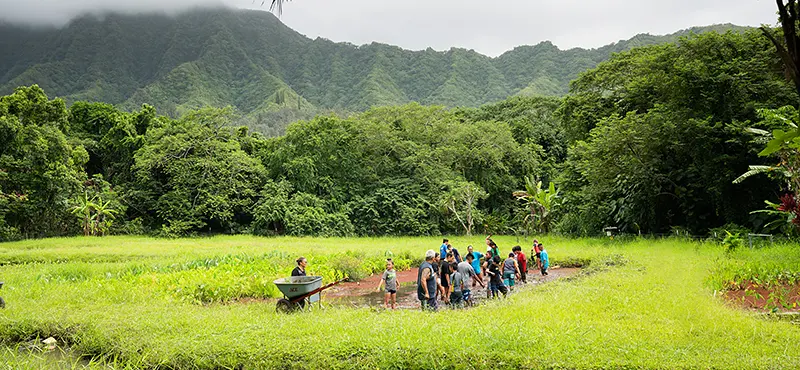Founders
The Kamehameha Ali‘i
The Kālakaua ‘ohana
From the Monarchy Series by Kamehameha Publishing available in English and ‘Ōlelo Hawai‘i
Kamehameha Nui
KAMEHAMEHA NUI was born at Kokoiki, Kohala on the Island of Hawai‘i (Kamakau, Ruling Chiefs of Hawaii, 67,68) around 1758. In 1795, his warriors were victorious over O‘ahu at the Battle of Nu‘uanu making him ali‘i nui over all the islands except Kaua‘i until 1810 when Kaumuali‘i surrendered his island to Kamehameha.
His hegemony was complete at a time when many nations were increasing their presence and activity in the Pacific. On May 8, 1819 he died at Kailua-Kona on the Island of Hawai‘i.
He had over 20 wives but only 3 were the highest ranking ali‘i whose children were heirs to the throne of the Kindom of Hawai‘i. Keopuolani (1778-1823), the highest ranking ali‘i, was the mother of Liholiho ‘Iolani (Kamehameha II), Kauikeaouli (Kamehameha III), and Nahi‘ena‘ena. Kalākaua (?-1842) was the mother of Kina‘u, the grandmother of Alexander of Liholiho (Kamehameha IV) and Lot Kapuaiwa (Kamehameha V). Kanekapolei was the mother of Ka‘oleioku, the grandmother of Konia (1808-1857), and the great grandmother of Ruth Ke‘elikolani (1826-1883) and Bernice Pauahi (1831-1880).
‘O Kamehameha lani kā‘eu ke ‘ano kapu/ ‘O ka haku manawa kapu ali‘i kēnā/ He ali‘i no ka mu‘o lani kapu o Lono/ Nona ke kapu, ka wela/ Ke hahana i holo i luna o ka wēkiu/ Lū ka ōla‘i, naue ka honua/ ‘Oni ke kai, nāueue ka moku/ ‘Ike i ka lepa koa a ka lani/ Hā’awi wale mai ‘o Kahekili/ Ua lilo ia kalani nui Keku’iapoiwa i ke kapu/ ‘Anapu wela ma ka honua mea/ He inoa/ He inoa no ka lani Kamehameha kapu ali‘i,/ He inoa/ He inoa no Kamehameha
(Chanted by Ka‘upena Wong during the dedication ceremony of the statue of Kamehameha in Washington D.C. in 1969.)
Stewart, Julie Williams, Kamehameha The Great, Honolulu, Hawaii: Kamehameha Schools/Bernice Pauahi Bishop Estate, Intermediate Reading Program, Community Education Division, 1992.
KAMEHAMEHA II
KAMEHAMEHA II (‘IOLANI LIHOLIHO) was born on 1796 or 1797 in Hilo on the Island of Hawai‘i. KEOPUOLANI, his father‘s most kapu (sacred) wife, was his mother. Liholiho outranked his father. Liholiho was raised by KA‘AHUMANU, his father’s favorite wife.
He became ali‘i nui upon the death of his father in 1819. Ka‘ahumanu became kuhina nui (co-ruler, prime minister). He enjoyed the company of foreigners. Ka‘ahumanu wanted to abolish the kapu for many reasons, but Liholiho was trained to uphold it. Many regulations were beneficial such as the conservation of freshwater, fish and plants. His own sacred mother Keopuolani and brother, KAUIKEAOULI broke the ‘ai kapu to prove that no immediate harm resulted. He agreed.
Change was relentless. In 1819, the French made Christian converts, the chiefs were permitted to trade ‘iliahi (sandalwood) for foreign goods, and whale ships berthed for provisions. In 1820, American missionaries arrived. Foreign contact proved disastrous for Hawaiians. Diseases to which they had no immunity like the common cold or measles killed large numbers. Drunken sailors set an unfavorable example.
Intermarriage increased the part-Hawaiian population. Foreign animals, plants, insects, and manufactured goods intruded. A new mercantile economic system replaced the subsistence barter system and business centers arose. Absolute power of the ali‘i nui was compromised and with it the old way of life.
Kamehameha II and his queen, Kamāmalu, died of measles in 1824 while visiting Great Britain.
Stewart, Julie Williams and Suelyn Ching Tune. Kamehameha II: Liholiho and the Impact of Change, Honolulu: Kamehameha Schools Press, 2001.
KAMEHAMEHA III
KAMEHAMEHA III (KAUIKEAOULI) was born at Keauhou, Kona on the Island of Hawai‘i in 1817. He was taught by American Christian missionaries at his kapu mother, Keopuolani‘s, insistence.
Kauikeaouli was chosen successor while his brother, Kamehameha II and Queen Kamāmalu sailed to Great Britain. He was 7 years old when they died in 1824. Ka‘ahumanu continued as kuhina nui. His reign was marked by a greater sharing of power with kuhina nui, a Council of Chiefs and his people. He was greatly influenced by American Christian missionaries.
Convinced that all people have certain rights, he issued a Declaration of Rights in 1839 and a Constitution in 1840. He also limited his powers granting maka‘āinana the right to vote. In 1844, the United States, Great Britain and France formally recognized the Hawaiian kingdom as an independent nation.
Land ownership was unkown in ancient Hawai‘i. The ali‘i nui was steward of all lands for the good of all. In 1848, Kamehameha III permitted an unprecedented system of land division and ownership, the Great Mahele. Originally, one third of the land was allotted to ali‘i. The king‘s portion was called Crown lands. 245 chiefs were to divide what was called Konohiki lands. One-third of the land was planned to be government lands and the remaining third was to be given to the maka‘āinana by the Kuleana Act of 1850. The proportions changed over time.
In 1850, the Resident Alien Act gave foreigners the right to own land in fee. Kamehameha III began to think that annexation to the United States was in his people‘s best interest.
Population had plummeted from a high in 1778of about 300,000 to a low of about 60,000 by 1850. Kamehameha III died on December 16, 1854 after an eventful 30 year reign.
Cachola, Jean Iwata, Kamehameha III: Kauikeaouli. Honolulu: Kamehameha Schools Press, 1995.
KAMEHAMEHA IV
KAMEHAMEHA IV (ALEXANDER LIHOLIHO ‘IOLANI) was born on February 9, 1834, grandson of Kamehameha I. He entered the Chiefs‘ Children‘s School run by Mr. and Mrs. Amos Starr Cooke when he was six.
At age 14, he left school to study law with William Little. At age 15 he and Lot traveled with Dr. Judd to the United States and Europe. He was fluent in the English language. He marreid Emma Na‘ea Rooke on June 19, 1856. They had one son, Albert Edward, who died at age four in 1862.
At age 20, he became Kamehameha IV and swore to uphold the Constitution of 1852. He did not agree that annexation to the United States was in the best interest of his people, but American sugar planters were becoming economically and politically powerful.
In 1860, the King and Queen founded the Queen’s Hospital for their sick and dying people. They invited the Church of England to establish a church and were sympathetic to British interests. He died on November 30, 1863 of asthma. He was 29 years old.
Lowe, Ruby Hasegawa, Kamehameha IV: Alexander Liholiho. Honolulu: Kamehameha Schools Press, 1997.
KAMEHAMEHA V
KAMEHAMEHA V (LOT KAPUAIWA) was born in Honolulu on December 11, 1830, grandson of Kamehameha I. He was 9 years old when he entered the Chiefs’ Children’s School. The ali‘i wanted their children trained in Western as well as Hawaiian traditions.
In 1849, Lot and Alexander Liholiho, his brother, began their year-long trip to the United States and Europe. When he returned, he was appointed a member of the House of Nobles and began government service.
He became King upon the death of Alexander Liholiho in 1863. Kamehameha V modeled his leadership after that of his grandfather, Kamehameha I, believing that it was the right and duty of the chiefs to lead the common people.
He refused to support the Constitution of 1852. By supporting the controversial Constitution of 1864, he expected to regain some of the powers lost by previous kings. Like his brother, he preferred the British monarchy and their traditions. He opposed American annexation of Hawai‘i.
Because the Hawaiian population was at its lowest in the 1850s, Kamehameha V agreed with the sugar planters to hire workers from other countries. Chinese immigrated in 1852, then Japanese, and many from other nations followed. Steamships brought travelers. New buildings were constructed. The Royal Hawaiian Band was the King‘s gift of music to his people.
The King died on December 11, 1872 without a successor.
Comeau, Rosalin Uphus, Kamehameha V: Lot Kapuaiwa. Honolulu: Kamehameha Schools Press, 1996.
RUTH KE‘ELIKOLANI
RUTH KE‘ELIKOLANI was born in 1826 at Pohukaina, O‘ahu.
BERNICE PAUAHI
BERNICE PAUAHI was born on December 19, 1831 at Honolulu, O‘ahu.
Both women were great-granddaughters of Kamehameha I. They were not rulers, but were the last surviving descendants of Kamehameha I by his four highest ranking, sacred wives.
The Constitution directed the Legislature to elect a King from the Ali‘i. WILLIAM CHARLES LUNALILO, a grand nephew of Kamehameha I, was chosen on January 1, 1873. He died of tuberculosis over a year later on February 3, 1874.
DAVID KALĀKAUA
DAVID KALĀKAUA, born on November 16, 1836 near Puowaina, island of O‘ahu, was the son of Chief Caesar Kapa‘akea and Chiefess Anale‘a Keohokalole. His sister Lydia Lili‘u Kamaka‘eha would become his successor, Queen Lilu‘okalani. His wife was Kapi‘olani and his niece was Ka‘iulani Cleghorn.
He attended the Chiefs‘ Children‘s School. At 14, he trained with the Prussian Franz Funk and at age 16 was commissioned a captain in the Hawaiian army. At 17, he studied law with C.C. Harris who would become Chief Justice of Hawai‘i.
He was a major on King Kamehameha IV‘s staff, a member of the Privy Council in 1856, a member of the House of Nobles in 1858, Postmaster General in 1863 and the King‘s Chamberlain in 1863 under Kamehameha V. In 1873, David Kalākaua became the Kingdom‘s first popularly elected monarch campaigning against the Dowager Queen Emma Kaleleonalani. In 1877, he dedicated the 155 acre Kapi‘olani Park in honor of his wife. He was a supporter of traditional Hawaiian hula and music and was an accomplished writer and composer. He wrote the words for Hawai‘i Pono‘ī to Henry Berger’s music.
He was also interested in science, technology, and languages. He signed a Reciprocity Treaty with the United States that allowed Hawaiian sugar and rice to be imported without tax in return for the use of Pearl Harbor as a naval facility. He built ‘Iolani Palace, commissioned the creation of crowns and jewels and traveled around the world.
On July 6, 1887, he was forced to sign a new consititution giving away much of his authority to a cabinet of ministers. Revolutionary forces menaced. HE died on January 20, 1891 in San Francisco of Bright‘s disease, a kidney ailment.
Lowe, Ruby Hasegawa. David Kalākaua. Honolulu: Kamehameha Schools Press, 1999.
LILI‘UOKALANI
LILI‘UOKALANI (LILI‘U KAMAKA‘EHA) was born on September 2, 1838. She entered the Chiefs’ Children’s School when she was 4 years old. When she was 24, she married John Owen Dominis, whom she knew as a youth.
When her brother became King, she became a Princess and traveled aroudn the islands attending to the needs of her people. She traveled to England in 1887 for Queen Victoria’s Golden Jubilee and as translator for Queen Kapi‘olani who spoke only Hawaiian.
She was a gifted musician and composer. She became Queen in 1891. She disagreed with the Constitution of 1887 forced upon her brother and proceeded to write a new one. Primary provisions were that only male Hawaiian born, or naturalized subjects could vote and that the monarch did not need the Cabinet’s approval for government decisions.
Dissenting pro-American businessmen desired annexation to the United States. This they achieved on January 17, 1893 by proclamation. Annexationists then lobbied the U.S. President for recognition. President Grover Cleveland sent Commissioner Blount to evaluate the situation. Agreeing with the Blount report, President Cleveland and the U.S. House did not support the Provisional Government and instructed annexationists to return the government to its ruler. The instructions were ignored. On January 16, 1895, Queen Lili‘uokalani was sentenced to house arrest. The Queen lobbied in Washington D.C. to no avail. On July 7, 1898, President William McKinley signed a resolution annexing Hawai‘i to the United States. The kingdom was lost.
Ke Aloha O Ka Haku otherwise known as The Queen’s Prayer was composed while under house arrest in 1895:
‘O kou aloha nō/ Aia i ka lani/ A ‘o kou ‘oia‘i‘o/ He hemolele ho‘i.
Ko noho mihi ‘ana/ A pa‘ahao/ ‘O ‘oe ku‘u lama/ Kou nani ko‘u ko‘o
Mai nānā ‘ino‘ino/ Nā hewa o kānaka/ Akā e huikala/ E ma‘ema‘e nō
No laila e ka Haku/ Ma lalo o kou ‘eheu/ Ko mākou maluhia/ A mau loa aku nō.
Lowe, Ruby Hasegawa. Lili‘uokalani. Honolulu: Kamehameha Schools Press, 1994.











